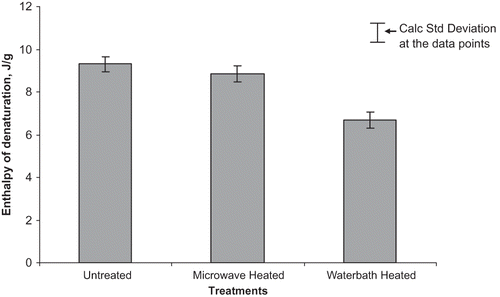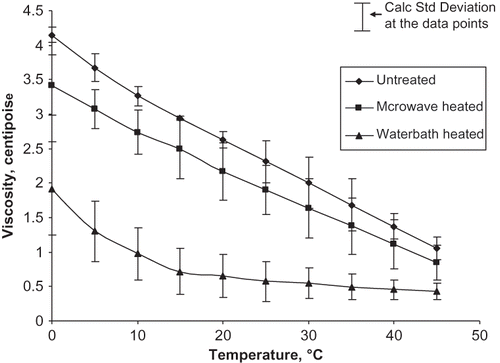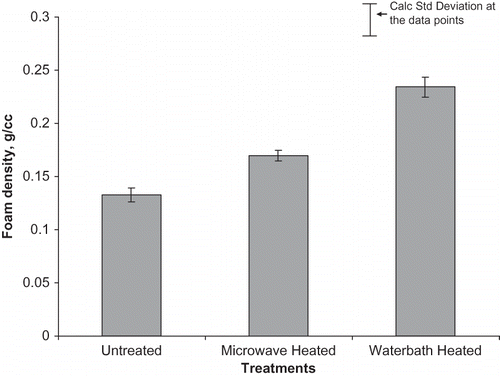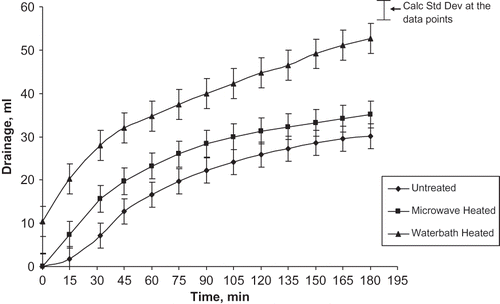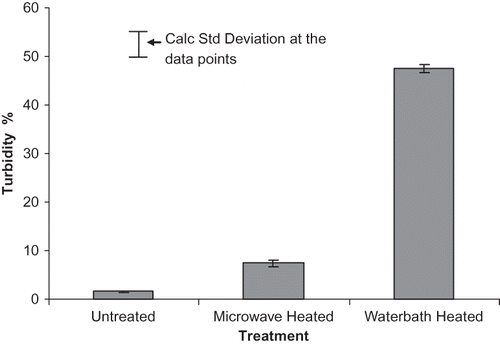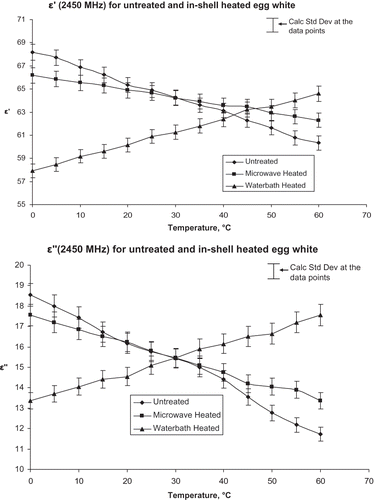Abstract
Heat treatments adversely affect the functional properties of the egg white. The selected properties of egg white after in-shell pasteurization by microwave heating were compared to that of egg white after in-shell pasteurization by immersion in hot water. The effects of the heat treatments on egg white enthalpy of denaturation, viscosity, turbidity, foam density, and stability, and also the dielectric properties, were investigated and compared to that of untreated egg white. Results demonstrated that microwave pasteurized in-shell eggs had nearly 20% higher enthalpy of denaturation, 4 times more viscosity, 50% more stable foam with 30% less foam density and 78% clearer, on an average, when compared to the water bath pasteurized ones.
INTRODUCTION
Eggs are popular for the exceptional functional properties of its two major components: the egg white and the yolk. Egg white is used as a foaming, leavening, gelling and/or binding agent in numerous food preparations. Also Egg white proteins are the most heat sensitive components of an egg. Egg yolk has good emulsifying and binding properties too.[Citation1] The physical properties like whipability, foamability, foam stability, viscosity, etc., affect the functional properties, which make the eggs an inevitable ingredient of various food products. These properties are severely affected by high temperatures.[Citation2]
Due to its exceptional nutritive value, eggs remain a potential host for pathogens like Salmonella enteritidis. More than 90 percent of food borne Salmonellosis, caused by Salmonella enteritidis is through the shell eggs.[Citation3,Citation4] Most of the Salmonella enteritidis outbreaks generally involved Grade A eggs that are washed and disinfected and also met the requirements of the state for shell quality.[Citation5] This proves the fact that the eggs were contaminated with Salmonella internally and the bacteria doesn't migrate from the shell during breaking and handling. The probability of fresh eggs having Salmonella varies from 0.005%[Citation6] to 1%[Citation7] depending on various factors involved in the egg production.
Thermal processing methods are the most widely used technique for destroying microorganisms and imparting foods with a lasting shelf-life, among which pasteurization has got its own prominent and predestined applications. Pasteurized foods are safety assured for the consumer within the recommended storage period and storage conditions. Though pasteurized foods are not totally free from pathogens, any possible pathogen contamination in the food is brought to safe limits and are guaranteed safe for a specified period of time and only when stored under the recommended storage conditions. The pathogen count may grow past the safe limits after that time. Today various techniques are applied for the pasteurization and thermal processing of foods. The conventional methods of thermal processing of foods result in peripheral over heating before the food in the centre reaches the required temperature. This is potentially a great problem in pasteurization, especially when it comes to shell eggs.
The Food Safety and Inspection Service (FSIS) of United States Department of Agriculture (USDA) recommends heating the egg white and the egg yolk to 57.5°C and 61.1°C, respectively, for 2.5 minutes to ensure egg safety against salmonella and other food borne pathogens.[Citation8] The existing method of pasteurizing the shell eggs uses immersion in hot water at 60°C for 20 minutes, results in overheating of the egg white and partially cooked eggs.[Citation6,Citation9] There are different protein fractions namely conalbumin, ovalbumin, ovotransferin, ovomucoid, ovomucin, globulins, lyzozyme, etc., that are contributing to the functional properties of the egg white as a whole.[Citation10,Citation11] The denaturation of some of these proteins starts at temperatures as low as 45°C.
Studies on the physicochemical changes due to heat treatment of egg white revealed that at lower temperatures (<50°C) these changes were only temperature dependent, but at higher temperatures (>50°C) the time factor, plays an important role, indicating a time-temperature-dependent level of denaturation with an equilibrium (denaturation-saturation) time.[Citation2] Therefore, the total time of heating is crucial for a better quality pasteurized egg white.
Dev et al.[Citation12] demonstrated that microwave heating could be an inimitable alternative to overcome the problem of peripheral overheating during shell egg pasteurization. Also the FSIS recommendation of heating up the yolk to a higher temperature (61.1°C) was absolutely possible without heating the egg white beyond its recommended pasteurization temperature (57.5°C). The risk of great pressure build-up within the egg shell when heated using microwaves is not inevitable within the pasteurization temperatures.[Citation13,Citation14] A comprehensive assessment of the functional quality of the microwave heated eggs can be done by examining the changes in the physical properties responsible for that.
Heat induced changes are more pronounced in the egg white that the egg yolk within the pasteurization temperature limits and therefore egg white would be a suitable indicator for the comparison of such changes.[Citation1] Therefore this paper focuses on comparison of microwave and water bath heated egg white for in-shell pasteurization with the raw egg white for the heat induced changes with respect to selected properties like enthalpy of denaturation, viscosity, foam density, foam stability, turbidity and dielectric properties.
MATERIALS AND METHODS
In-shell egg was pasteurized using a laboratory microwave oven setup and using hot water bath maintained at 60°C. Effects of heat treatments on the physical properties affecting the functional quality of the egg white recovered from the treated eggs were measured and compared to that of fresh untreated egg white.
Egg Samples
The fresh whole eggs, within 3 days of grading and packing (identified from the best before date stamped on the eggs, which is usually 35 days from date of packing),[Citation15]used in this study were procured from the local market and kept in a refrigerator at 5°C until used. They were all of Canadian Grade A eggs and of large size, each with an average mass of 60 ± 2 g. Prior to pasteurization, the eggs were brought to room temperature of about 24°C by placing the opened carton on the laboratory counter for a period of 3 to 4 h (tested by breaking and measuring inner temperatures of 3 representative samples) before giving the heat treatments. This was done to replicate the possible use of this technique in the industry, wherein significant amount of energy can be saved by doing so.
Heat treatments for pasteurization
Two heat treatments for the pasteurization of in-shell eggs were investigated and compared. Each treatment was performed in triplicates, i.e., three eggs were used for each treatment for the measurement of each parameter within the scope of this study. The first treatment consisted of heating in-shell eggs in a laboratory scale microwave oven working at 2450 MHz using a power density of 1 W/g. In-shell egg white was heated for 7 min to raise the temperature to 58°C and held at 58 ± 0.5°C for 2.5 min, by periodically turning the microwave cycles on and off, as per the FSIS-USDA recommendation.[Citation8] The temperature was measured using a fiber optic probe inserted into the egg white through the shell and the microwave operation was controlled by the computer running HPVEE (Agilent) object oriented programming language to maintain the desired process temperature.
The second treatment consisted of immersing the in-shell egg in a temperature controlled water bath maintained at 60°C for a period of 20 min.[Citation16] These eggs were left intact without any inserted probes, as this was a commercially practiced technique, approved by FSIS-USDA. The temperatures reached by the egg components using the microwave and water bath heating may not be identical. However, the objective of this study was to compare the properties of the egg white pasteurized in shell by the proposed (microwave) technique with that of the commercially practiced (water bath) technique, both meeting the FSIS-USDA pasteurization requirements/recommendations. Immediately after both the above mentioned heat treatments the shell eggs were immersed in cold water tub containing water at 5°C for 10 min. This was done to ensure that the extent of heat damage to the proteins did not continue any longer after the pasteurization.
Measurements of the egg white physical properties
The properties attributed to the functional quality of the egg white of in-shell heat-treated and untreated eggs were measured and compared. Eggs were cracked carefully and the egg white was collected in small cylindrical beakers. Shells and yolks were discarded. All measurements were taken in triplicates. Parameters measured to assess the functional properties of egg white were enthalpy of protein denaturation, the viscosity, foam density and foam stability, turbidity, and dielectric properties.
Enthalpy of Protein Denaturation
The instrument used to measure the enthalpy of denaturation was a TA Instruments Q100 Differential Scanning Calorimeter operated with the TA Instruments Q100 DSC 7.0 Build 244 software. Untreated and heat-treated samples were first placed in aluminum pans (20 μl/pan) and then hermetically sealed. The pans were transferred to the instrument pan holder and heated from 20°C to 120°C at a constant rate of 10°C/min. An empty pan was used as a reference. The sample residual enthalpy was the recorded at the denaturation temperature of 83°C. Nitrogen was used as purge gas during the analysis. The DSC was calibrated with indium and sapphire for temperature and heat capacity. An empty pan was used as a reference to balance the heat capacity of the sample pan. In the experiment, sample pans were equilibrated to 10°C and held isothermal for another 2 min. As thermal denaturation of proteins is always an endothermic reaction, it is always accompanied by a peak in the heat flow graph. The area under the peak gives the enthalpy of denaturation.[Citation2]
Viscosity
An Oswald viscometer and a temperature controlled water bath were used for measurement and comparison of the egg white viscosity. Measurements were made on all samples at temperature ranging from 0°C to 45°C for every 5°C increment in temperature. Measurements of viscosity could not be made above 45°C as any further increase in temperature may lead to further denaturation and clogging of the viscometer capillary. For each sample, measured viscosity values were plotted against temperature and analyzed.
Foam Density and Foam Stability
Each egg white sample was foamed in a cylindrical beaker (500 ml) with a Braun 60 Egg Beater (USA). The foaming process consisted of beating 50 g of egg white for 2 min at a speed of 2000 rpm. The foam density was then measured and the foam stability was taken as the quantity of liquid drained as a function of time from the completion of foaming. Foam stability measurements were taken for 180 minutes after foaming.
Turbidity
Turbidity is a direct measure of the extent of protein coagulation, as coagulated proteins are opaque and reduce the transmittance of light through the egg white. The amount of light absorbed (absorbance) is a function of the turbidity of a liquid. The absorbance of the heat treated and untreated egg white samples was measured at 650 nm[Citation2] using a Biochrom Ultra spec 2100 Pro spectrophotometer at 24°C. Plain demineralised water was used for calibration. An absorbance (turbidity) of 0% corresponded to a totally clear solution.
Dielectric Properties
The change in dielectric properties is considered a good indicator of the extent of denaturation of the egg white proteins.[Citation17]The open-ended coaxial probe technique was used to measure and compare the dielectric properties of heat-treated and untreated samples (). Measurements of the dielectric properties were made with an Agilent 8722 ES s-parameter Network Analyzer equipped with the high temperature probe model 85070B. This instrument was controlled with the Agilent 85070D Dielectric Probe Kit Software Version E01.02. According to the manufacturer, the equipment has an accuracy of ±5% for the dielectric constant (ϵ') and ±0.005 for the loss factor (ϵ”).[Citation18] The dielectric property measurements (ϵ' and ϵ”) were taken at 2450 MHz for every 5°C rise in temperature from 0°C to 60°C.
Data analysis
All the data obtained were statistically analyzed using the software MATLAB-7.0.1 from Mathworks. Analyses of variances followed by Duncan's multiple range tests were conducted to locate significant differences among means. In all comparisons, significant deviations from mean values obtained from untreated egg white were considered to have an adverse effect on the egg white's functional properties.
RESULTS AND DISCUSSION
Enthalpy of Protein Denaturation
The enthalpy of denaturation is the net value of the combination of endothermic reactions, such as the disruption of hydrogen bonds, and of exothermic processes, such as the breakup of hydrophobic interactions and protein aggregations. The resulting residual enthalpy has been correlated to the remaining content of ordered secondary structure of a protein.[Citation2] As shown in the , reductions in residual enthalpy indicated that the heat treatments had partially denatured the egg white proteins of all heat treated samples. However, microwave treated samples exhibited less reductions than samples heated in the hot water bath. This implied that denaturation was very less in the microwave heated in-shell egg. These results corroborate the work by Iesel Van der Plancken et al.[Citation2] and Ahmed et al.[Citation19] for the heat treated egg white. Statistical analysis performed on the data revealed that the difference in mean enthalpy of the egg white between microwave heated and the untreated (raw) in-shell eggs was not significant (P < 0.01), whereas the water bath heated in-shell eggs had considerable (P < 0.01) lower enthalpy from the others.
Viscosity
The egg white viscosity of heat treated eggs were lower than that of untreated eggs (), and decreased with temperature[Citation20] and the level of protein denaturation. At higher temperatures, differences among the treatments were lower than at lower temperatures. An overview of the data in depicts that all the three samples had a considerable difference among them at lower temperatures. Mehmet Resat Atlgan et al.[Citation21] also obtained similar results in the temperature ranges tested for. The results of the statistical analysis (ANOVA & Duncan's Test) were similar to that of the enthalpy of denaturation. The viscosity of in-shell microwave heated egg white was not significantly different (P < 0.05) from the viscosity of the untreated ones, whereas the water bath heated samples were significantly different (P < 0.05) from the other two.
Foam Density and Foam stability
Foam density is a measure of the thickness of the foam, which gives a clear picture of the quantity of air incorporated in the egg white foam. This important factor tells about the aerating properties of the egg white in its food applications. The stability of the egg foam is a crucial parameter for the functional quality of the egg white. The commercial use of egg white is highly dependent on its foam stability in many of its applications in the food industry.[Citation10]
Good foaming property is associated with a low foam density. The analysis performed on the foam density data indicated that heat treated egg white samples had significantly higher values than untreated egg white samples (). The foam density of the egg white of the microwave heated in-shell egg was lower than that of water bath heated in-shell eggs making them more suitable for commercial applications. The foam stability reported as the amount of drained liquid as a function of time indicated that microwave heated samples had a foam stability closer to that of the untreated eggs (), whereas the water bath heated samples had poor foam stability. Statistical analysis (ANOVA & Duncan's Test) revealed that the differences in foam stability between the microwave heated in-shell egg and the untreated ones was not significant (P < 0.05). The stability of the foam made with the egg white of the eggs heated in the water bath was significantly lower than the two others.
Turbidity
The analysis performed on the turbidity of the egg white samples measured as the absorbance at 650 nm indicated that the microwave heated in-shell egg white had better transmittance than the water bath heated ones (). This implies that the extent of denaturation is much lesser in the microwave heated samples as coagulation due to denaturation increases turbidity.[Citation2] Differences in mean turbidity values for the egg white taken from untreated, microwave heated or water bath heated eggs were all significant at the 0.01 level. Absorbance values of the microwave heated samples were closer to the untreated ones.
Dielectric Properties
The dielectric constants and loss factors of the egg white of untreated eggs and of eggs heated in a microwave oven or in a hot water bath as a function of temperature are presented in . The trends observed in the dielectric properties measured at 2450 MHz of egg white of microwave heated in-shell eggs were similar to that of the untreated eggs. The dielectric properties of the egg white of the eggs treated in hot water exhibited a complete change in trend as they became directly proportional to the temperature. This behaviour was associated with a greater denaturation of proteins in these samples. The change in dielectric properties with temperature got reversed with denaturation, i.e., the dielectric properties were inversely proportional to the temperature when raw (untreated) and became directly proportional to temperature when denatured.[Citation17] Statistical analysis (GLM on curves and ANOVA and Duncan's test on the slopes and intercepts) revealed significant differences (P < 0.05) among all the samples.
CONCLUSIONS
The effects of microwave heating and hot water bath heating of in-shell eggs on the functional properties of the egg white was assessed and compared to that of untreated eggs. It was demonstrated that enthalpy denaturation was much higher for the microwave heated in-shell egg white and it was clearer and had a higher viscosity. The microwave heated egg white produced more stable foam with low foam density. In addition, the dielectric properties gave a lucid idea about the extent of denaturation in all the three samples. From the data obtained from all the tests conducted it had been confirmed that though there was a considerable change in all the above tested parameters in the microwave heated in-shell egg white, the changes were much less, i.e., nearly 20% higher enthalpy of denaturation than the water bath heated egg white and only 8% lesser than the raw egg white, the viscosity, foam density and foam stability of in-shell microwave heated egg white was not significantly different (P < 0.05) from that of the untreated ones, whereas the waterbath heated ones were significantly different. The microwave heated in-shell egg white was 50% more stable foam with 30% less foam density and 78% clearer, on an average, when compared to that of the water bath heated ones and these properties of the microwave heated in shell egg white were more closer to that of the raw (untreated) egg white. Thus, microwave was proven to be a viable and better alternative for the in-shell heating and pasteurization of shell eggs.
ACKNOWLEDGMENTS
The financial support by the Canadian International Development Agency (CIDA) and Natural Sciences and Engineering Research Council (NSERC) of Canada is greatly acknowledged.
REFERENCES
- Li-Chan , E. C.Y. , Powrie , W.D. and Nakai , S. 1995 . “ The chemistry of eggs and egg products ” . In Egg Science and Technology , Edited by: Stadelman , W.J. and Cotterill , O.J. 90 – 145 . New York : Food Products Press .
- Van der Plancken , I. , Van Loey , A. and Hendrickx , E.M. 2006 . Effect of heat-treatment on the physicochemical properties of egg white proteins: A kinetic study . Journal of Food Engineering , 75 ( 3 ) : 316 – 326 .
- Schroeder , C.M. , Naugle , A.L. , Schlosser , W.D. , Hogue , A.T. , Angulo , F.J. , Rose , J.S. , Ebel , E.D. , Disney , W.T. , Holt , K.G. and Goldman , D.P. 2005 . Estimate of Illnesses from Salmonella Enteritidis in Eggs, United States, 2000 . Emerging Infectious Diseases , 11 ( 1 ) : 113 – 115 .
- Woodward , D.L. , Khakhria , R. and Johnson , W.M . 1997 . Human Salmonellosis Associated with Exotic Pets . Journal of Clinical Microbiology , 35 ( 11 ) : 2786 – 2790 .
- St. Louis , M.E. , Morse , D.L. and Potter , M.E. 1988 . The Emergence of grade A eggs as a major source of Salmonella enteritidis infections: new implications for the control of salmonellosis . Journal of American Medical Association , 259 : 2103 – 2107 .
- Mermelstein , N.H. 2001 . Pasteurization of Shell Eggs . Food Technology , 12 : 72 73 79
- Griffiths , M.W. Issues Related to the Safety of Eggs and Egg Products . VIII International Seminar of Pathology and Poultry Production . October 9–10 . Edited by: Hidalgo , H. Santiago, , Chile : University of Chile. Chile. AMEVEA .
- FSIS-USDA. Risk Assessments for Salmonella enteritidis in Shell Eggs and Salmonella spp. in Egg Products. FSIS: Omaha, NE, 2006 http://www.fsis.usda.gov/oppde/rdad/FRPubs/04-034N/Hazard_Identification.pdf (http://www.fsis.usda.gov/oppde/rdad/FRPubs/04-034N/Hazard_Identification.pdf) (Accessed: 2 July 2010 ).
- Hou , H. , Singh , R.K. , Muriana , P.M. and Stadelman , W. J. 1996 . Pasteurization of intact shell eggs . Food Microbiology , 13 : 93 – 101 .
- McDonnell , L.R. , Feeney , R.E. , Hanson , H.L. , Campbell , A. and Sugihara , T.F. 1955 . The functional properties of the egg white proteins . Food Technology , 9 : 49 – 53 .
- Cunnningham , F.E. 1995 . “ Egg-Product Pasteurization ” . In Egg Science and Technology , Edited by: Stadelman , W.J. and Cotterill , O.J. 225 – 282 . New York : Food Products Press .
- Dev , S.R.S. , Raghavan , G.S.V. and Gariepy , Y. 2008 . Dielectric properties of egg components and microwave heating for in-shell pasteurization of eggs . Journal of Food Engineering , 86 : 207 – 214 .
- Fleischman , G.J. Microwave pasteurization of shell eggs . Proceedings of 2005 IFT Anual Meeting . July 15–20 . Las Vegas : IFT .
- Rehkopf , A. Quality validation of a microwave-pasteurization process for shell-eggs . IFT Annual Meeting . New Orleans, Louisiana.
- Canadian Egg Marketing Agency (CEMA) . 2004 . The Canadian Egg Industry Fact Sheet , Edited by: CEMA . Ottawa, , Canada : Canadian Egg Marketing Agency .
- Schuman , J.D. , Sheldon , B.W. , Vandepopuliere , J.M. and Ball Jr , H.R. 1997 . Immersion heat treatments for inactivation of Salmonella enteritidis with intact eggs . Journal of Applied Microbiology , 83 : 438 – 444 .
- Bircan , C. and Barringer , S.A. 2002 . Use of dielectric properties to detect egg protein denaturation . Journal of Microwave and Electromagnetic Energy , 37 ( 2 ) : 89 – 96 .
- HP . 1992 . “ Dielectric Probe Kit 85070A ” . In Test and Measure Measurements , Edited by: Unit , R.D. Palo Alto, CA : Hewlett Packard Corporation .
- Ahmed , J. , Ramaswamy , H.S. , Alli , I. and Raghavan , G.S.V. 2007 . Protein Denaturation, Rheology, and Gelation Characteristics of Radio-Frequency Heated Egg White Dispersions . International Journal of Food Properties , 10 ( 1 ) : 145 – 161 .
- Pitsilis , J.G. , Walton , H.V. and Cotterill , O.J. 1975 . The apparent viscosity of egg white at various temperatures and pH levels . Transactions of ASABE , 18 : 347 – 349 .
- Atlgan , M.R. and Unluturk , S. 2008 . Rheological Properties of Liquid Egg Products (LEPS) . International Journal of Food Properties , 11 ( 2 ) : 296 – 309 .

